Demolition Contractors Manor
Top Demolition Contractor in Manor
Get 3 FREE Demolition Contractors quotes for your project today! Compare profiles, reviews, accreditations, portfolio, etc... and choose the best service.

Staten Island Masonry- Staten Island Masonry Contractors
518 reviewsYork, USStaten Island Masonry Serving Staten Island and surrounding areas Staten Island Masonry and Concrete is the premier choice for masonry and concrete services in Staten Island. Our team of experienced masonry contractors specialize in a variety of services, including brick laying, block laying, and concrete work. We have been providing superior quality masonry and concrete services to Staten Island and the surrounding areas for over 20 years. We are committed to providing outstanding customer service and craftsmanship on every project. Our team is dedicated to providing the highest quality standard of work and strive to exceed our customers’ expectations. We take the time to understand your project and provide a tailored solution that meets your needs.
- Services
- Why Us?
- Testimonials
- Gallery
Get Quote
Mundis Excavating
53 reviews80 Manor Road, 80 MANOR ROAD, Red Lion, 17356, USAbout Us Red Lion local, Bob (Bobby) Mundis is the owner-operator of Mundis Excavating. Bob is the third generation excavator. He has 20+ years of experience in heavy equipment operation. Bob started his career as an operator for his father, Jay E. Mundis Excavating. He then moved on to become a project coordinator and later an estimator for a commercial contractor in Baltimore, MD. Bob oversaw projects in such institutions as NASA, Johns Hopkins University, and Johns Hopkins Hospital. In 2018, Bob decided to open his own excavating company in his home town of Red Lion. Maria Mundis Wife of Bob Mundis, Maria is the Controller of Mundis Excavating. Before graduating from Penn State University with Bachelor's of Science in Electro-Mechanical Engineering, Maria gained some work experience in banking industry. After completing an internship at Johnson Controls, Inc., Maria chose to become a stay-at-home mom to her and Bob's two children, later to begin helping Bob with his business. Family Owned Small Business Mundis Excavating was established in 2018 as a dream of one family to use our talents for honest service to others. Our company motto is: "A just scale and a fair measure." Our continuous goal is to work tirelessly in order to provide our customers with the best service and quality of work at affordable prices. We hope to continue growing our company in the years to come. Our Promise We are committed to providing honest and prompt service. The integrity of our business is our priority.
- Services
- Why Us?
- Our Team
- Gallery
Get Quote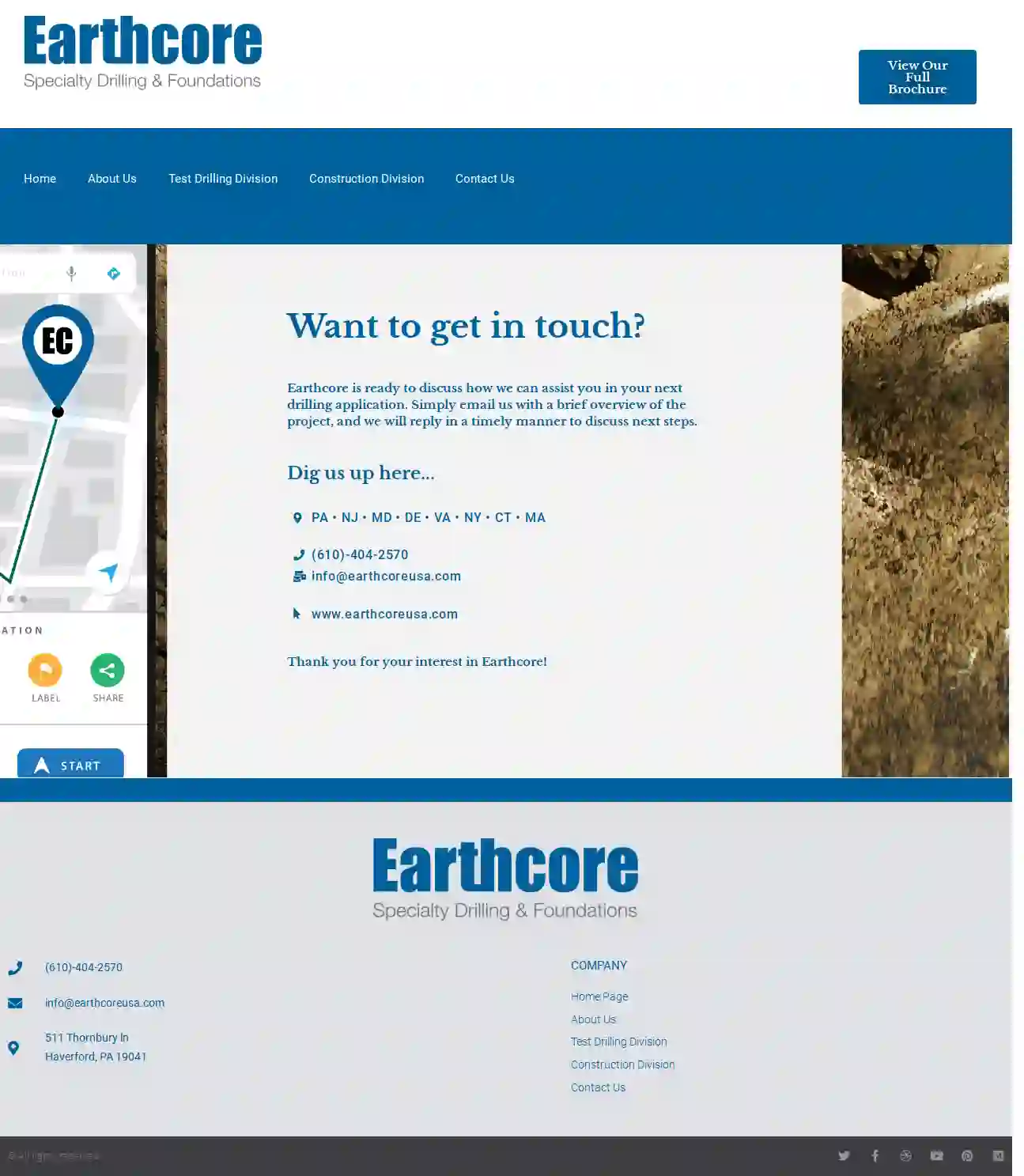
Earthcore
11 reviews455 Fairview Chapel Road, Birdsboro, 19508, USFor decades, engineers, contractors, and property owners alike have come to rely on Earthcore as the go-to resource to resolve their toughest drilling and foundation construction challenges. Headquartered in Birdsboro, PA, we deploy our crews across the Northeast and Mid-atlantic regions. With a proven track record of documented safety, certifications, and successful execution, Earthcore brings highly-experienced operators and a large, diverse fleet of powerful rigs to job-sites rapidly to get the job done right. We invite you to do a little digging of your own to learn how Earthcore may be the perfect solution for your project. Be it test borings, soil stabilization, or assistance with specialty foundation construction, we do it all.
- Services
- Why Us?
- Gallery
Get Quote
Kuharchik Construction
4.428 reviews420 Schooley Ave, Exeter, 18643, USWE ARE KUHARCHIK CONSTRUCTION. Providing superior electrical contracting services throughout Pennsylvania since 1973. We’re local, we’re family owned, we’re union! Kuharchik is your first choice in Electrical Contracting. From Highway Signing & Lighting to Foundation Installation, we take pride in every job that we do.
- Services
- Why Us?
- Gallery
Get Quote
Big Horn Excavating LLC
Lykens, PA, 17048, USExcavation Company It doesn’t matter whether an excavation job is straightforward or complex, every project could benefit from professionalism—and that is why so many people look to Big Horn Excavating LLC when they are in need. Offering exceptional excavation services, we are the contractors that set big projects in motion. We work alongside landscapers, homeowners, and general contractors on a regular basis. So whether you are looking for someone to prepare a site for basement construction or dredge silt and muck from a community pond, we are the ones you can count on. Skilled in All Excavation Services We pride ourselves on our versatile nature. Our contractors might find themselves offering services to aid in installing a stormwater drain one day, only to be excavating earth and topsoil for a backyard pond the next day. Some of the additional excavation services we offer include: Earth moving Grading Rock removal Basement excavation Site preparation services And more With so many services at your disposal, you will never have to look to another excavation team ever again. Reach out to us today to learn more about the services we offer. All the Excavation Equipment Needed Every excavation project is different. Thankfully, we are always prepared for whatever obstacle comes our way. Between our years of experience and vast storehouse of equipment, our accredited team always rises to the occasion. We move mountains for our clients—along with topsoil, earth, rock, and debris. When your upcoming project calls for an excavator, look to us. Serving the Entire Community We deliver grading and excavation solutions for industries and individuals of all distinctions. Some of the professionals we commonly work with include: Real estate developers Municipal construction operations Engineers Architecture firms General contractors Utility companies Our versatile nature allows us to envision the entire scope of our client’s construction projects. In doing so, we lay the best foundation possible for all the work to come. If you would like to learn more about our services, please feel free to contact our offices at your convenience. Excavation and Excellent Customer Service When it comes to your construction projects, you only want professionals on site. Rest assured, you will absolutely love our professional yet personable approach to excavation. We are always happy to answer your questions and address any concerns you might have.
- Services
- Why Us?
- Gallery
Get Quote
Weaver & Sons Excavation
55 reviews5147 Ore Bank Road East, York, 17406, USThe clear choice for all your excavation needs. These are our original pieces of equipment. While we have greatly expanded our fleet to address our clients' needs, our motto is still the same: "We want the small jobs the big guys don't want." SERVICES With over 30 years of experience in excavation and general construction, we can help you design a solution that meets your needs at a very reasonable cost. ABOUT Weaver and Sons Excavation started in 2007 when Mark Weaver closed his general construction business after 20 years. He decided to keep his excavation equipment and continue on as a part-time business. Eventually, business was good enough that he decided to go full-time. After going full-time, the Weaver and Sons office was relocated to a 200-year-old town hall building in Wrightsville that Mark personally renovated. We have since added a new shop and office in Hellam, York County. Mark's experience of over 30+ in the general construction business gives him the unique ability to advise on all phases of your project, as well as the excavation phase. Weaver and Sons can provide references from past residential clients, as well as numerous commercial contractors that use them regularly. Our mission is simple: Get in, get out, and leave a happy customer!
- Services
- Why Us?
- Our Team
- Gallery
Get Quote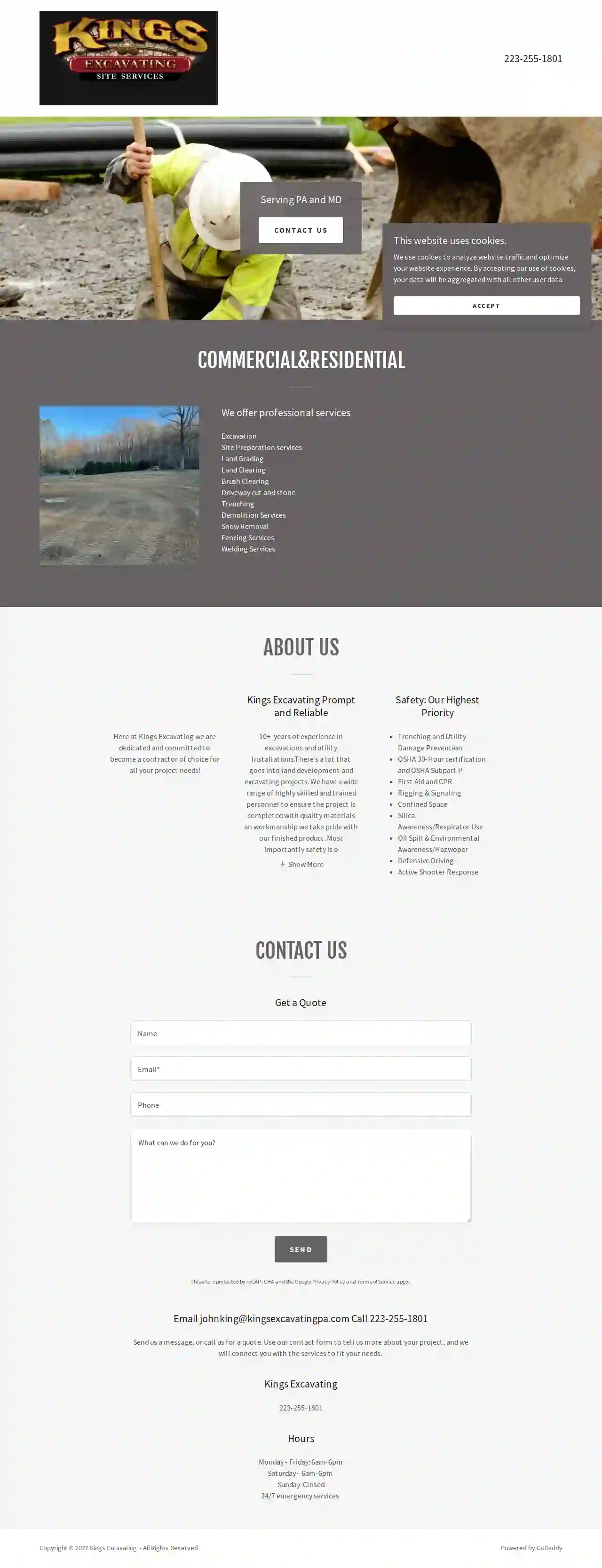
Kings Excavating
Pittsburgh, USKings Excavating: Prompt and Reliable Here at Kings Excavating, we are dedicated and committed to becoming your contractor of choice for all your project needs! With over 10 years of experience in excavations and utility installations, we have a wide range of highly skilled and trained personnel to ensure your project is completed with quality materials and workmanship. We take pride in our finished product, and most importantly, safety is our number one priority. We strive to create a safe working environment for our employees and the public throughout every project. Safety: Our Highest Priority We prioritize safety in all our operations, adhering to the highest industry standards. Our team is equipped with the necessary certifications and training to ensure a safe and efficient work environment. Our commitment to safety includes: Trenching and Utility Damage Prevention OSHA 30-Hour certification and OSHA Subpart P First Aid and CPR Rigging & Signaling Confined Space Silica Awareness/Respirator Use Oil Spill & Environmental Awareness/Hazwoper Defensive Driving Active Shooter Response
- Services
- Why Us?
- Gallery
Get Quote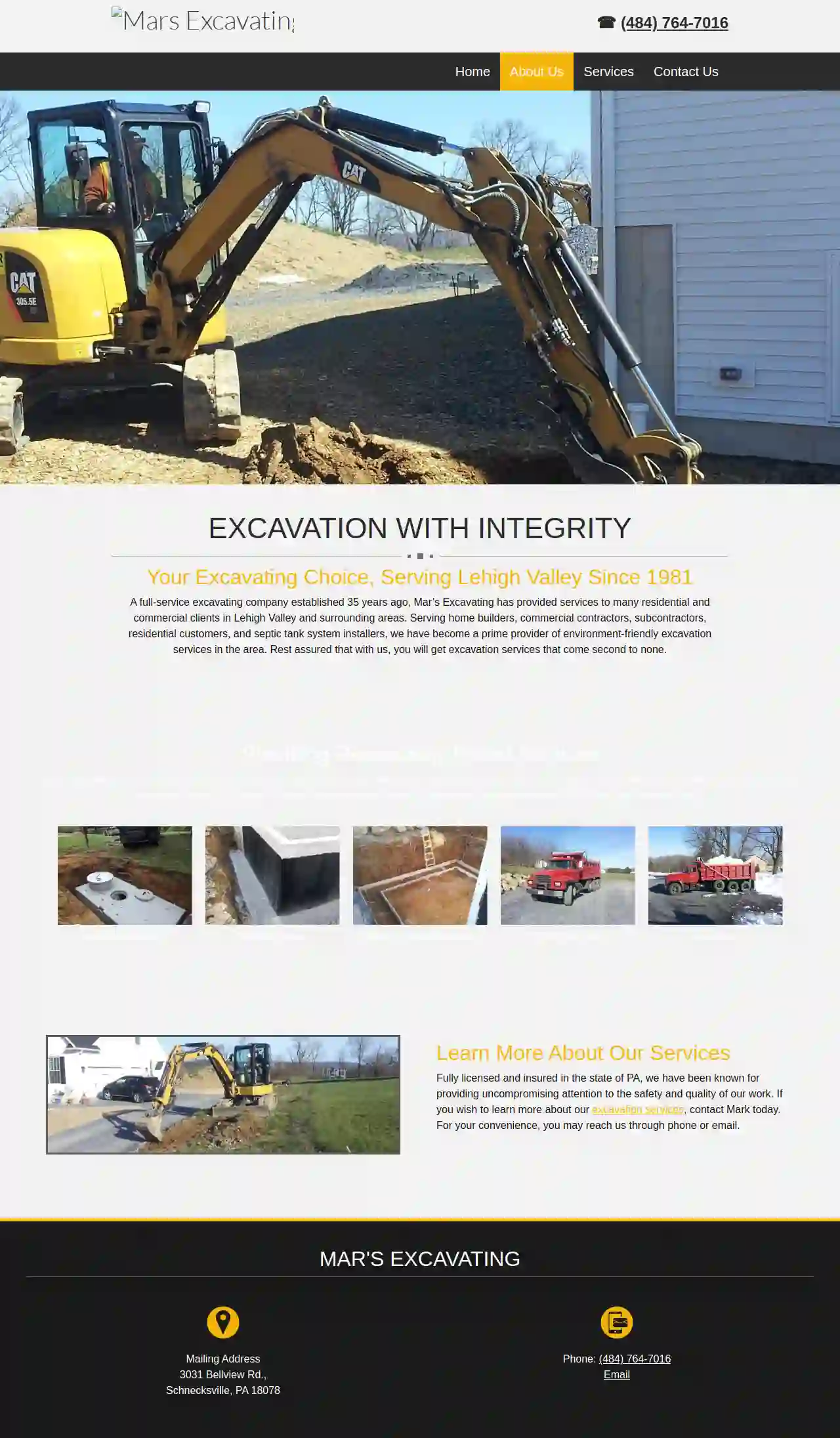
Mar's Excavating
3031 Bellview Rd., Schnecksville, 18078, USExcavation with Integrity Mar’s Excavating, a full-service excavating company established over 35 years ago, has been serving the Lehigh Valley and surrounding areas with exceptional excavation services. We are dedicated to providing environmentally friendly solutions for both residential and commercial clients, including home builders, commercial contractors, subcontractors, and septic tank system installers. Our commitment to quality and safety ensures that you receive excavation services that are second to none. Providing Reasonably Priced Services Our company was founded with the goal of bringing high-quality excavation services to the Lehigh Valley and surrounding areas. Our experienced team is dedicated to providing hands-on, accessible service for every project. We are committed to getting your job done right, on time, and within budget. Learn More About Our Services Fully licensed and insured in the state of Pennsylvania, we are known for our unwavering commitment to safety and quality. If you'd like to learn more about our excavation services, please don't hesitate to contact Mark today. You can reach us by phone or email for your convenience.
- Services
- Why Us?
- Our Team
- Gallery
Get Quote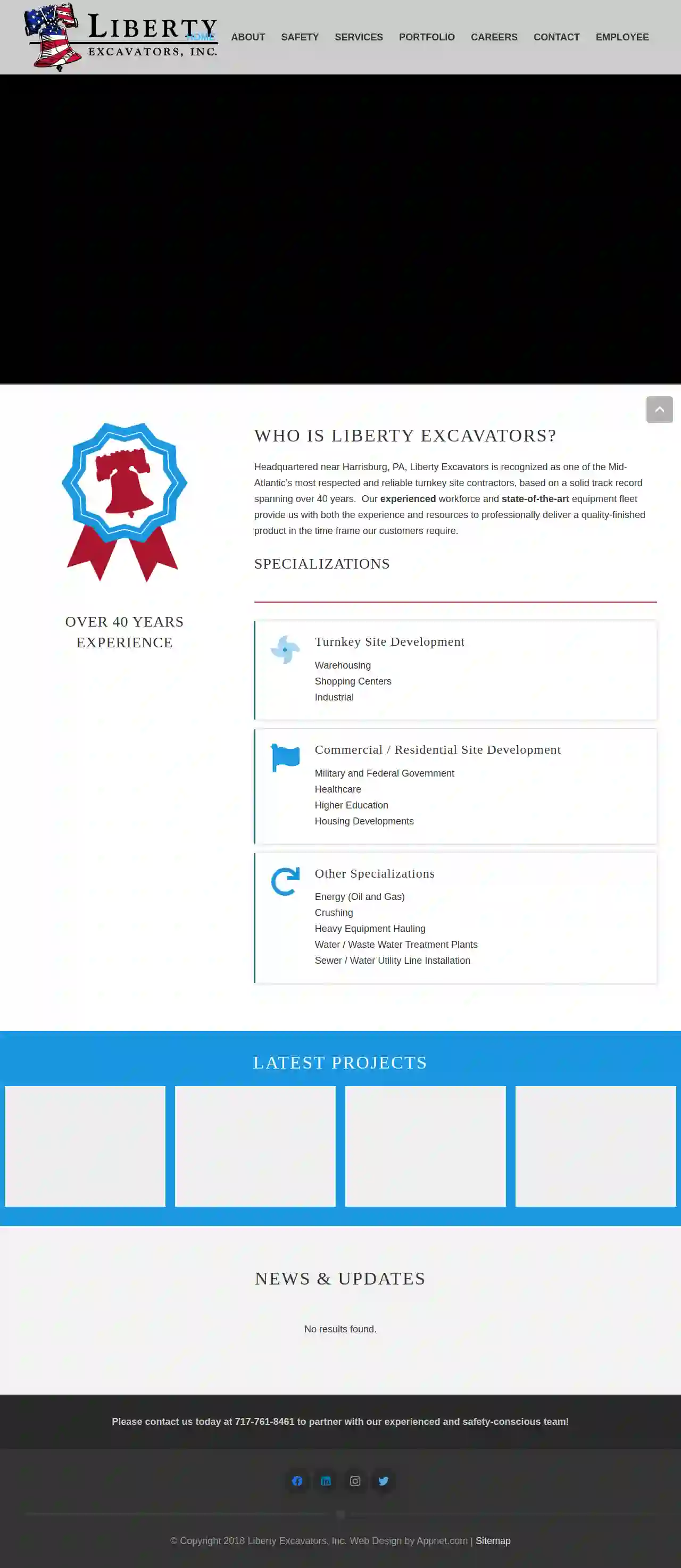
Liberty Excavators Inc
3.123 reviewsHarrisburg, USWho is Liberty Excavators? Headquartered near Harrisburg, PA, Liberty Excavators is recognized as one of the Mid-Atlantic’s most respected and reliable turnkey site contractors, based on a solid track record spanning over 40 years. Our experienced workforce and state-of-the-art equipment fleet provide us with both the experience and resources to professionally deliver a quality-finished product in the time frame our customers require. Specializations Liberty Excavators specializes in a wide range of projects, including: Turnkey Site Development Warehousing Shopping Centers Industrial Commercial / Residential Site Development Military and Federal Government Healthcare Higher Education Housing Developments Energy (Oil and Gas) Crushing Heavy Equipment Hauling Water / Waste Water Treatment Plants Sewer / Water Utility Line Installation
- Services
- Why Us?
- Gallery
Get Quote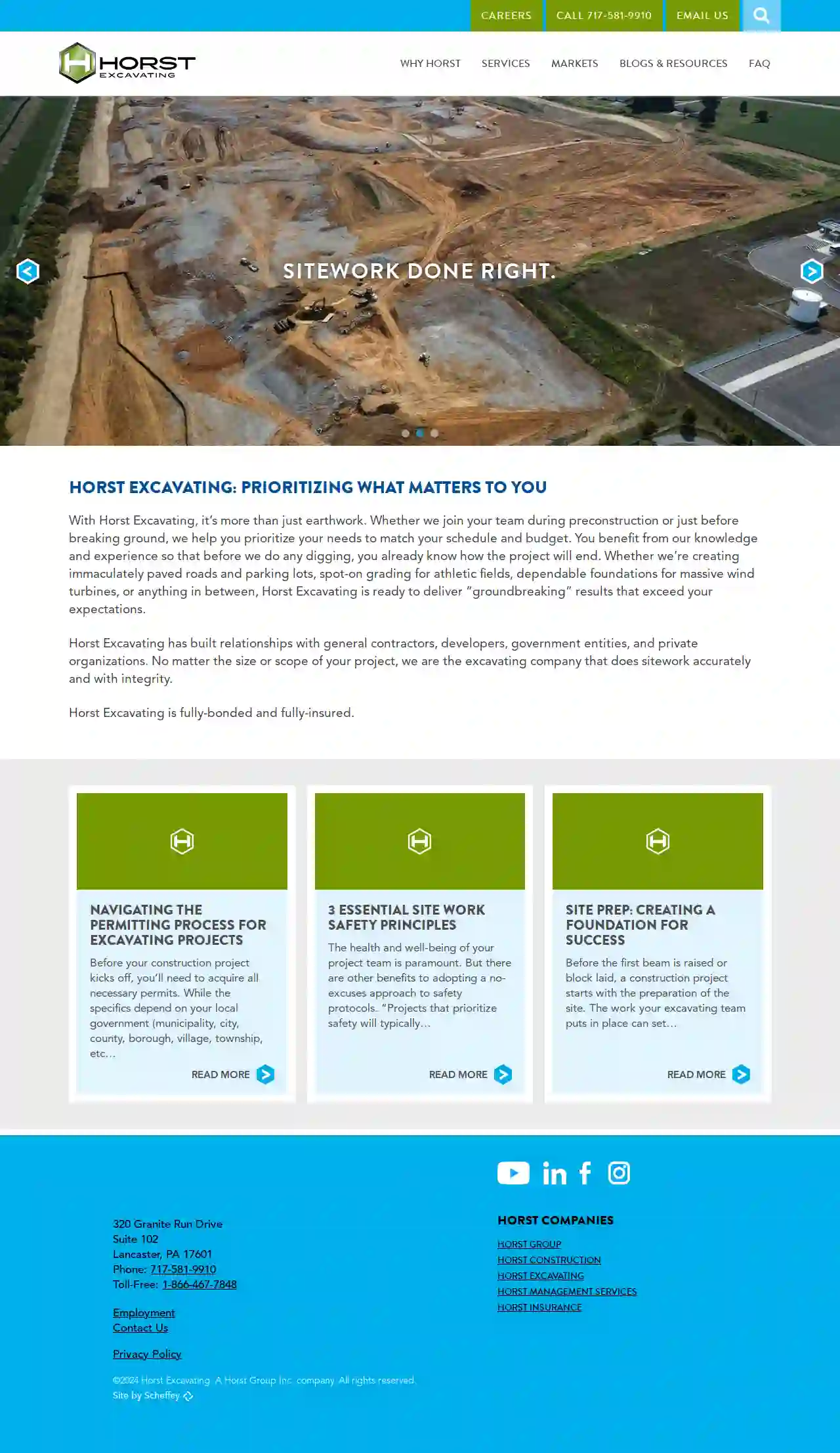
Horst Excavating
416 reviews320 Granite Run Drive, Suite 102, Lancaster, 17601, USHorst Excavating: Prioritizing What Matters To You With Horst Excavating, it’s more than just earthwork. Whether we join your team during preconstruction or just before breaking ground, we help you prioritize your needs to match your schedule and budget. You benefit from our knowledge and experience so that before we do any digging, you already know how the project will end. Whether we’re creating immaculately paved roads and parking lots, spot-on grading for athletic fields, dependable foundations for massive wind turbines, or anything in between, Horst Excavating is ready to deliver “groundbreaking” results that exceed your expectations. Horst Excavating has built relationships with general contractors, developers, government entities, and private organizations. No matter the size or scope of your project, we are the excavating company that does sitework accurately and with integrity. Horst Excavating is fully-bonded and fully-insured.
- Services
- Why Us?
- Gallery
Get Quote
Over 22,076+ Excavation Pros on our platform
Our excavation contractors operate in Manor and surrounding areas!
ExcavationHQ has curated and vetted Top Excavation Companies arround Manor. Find a reliable contractor today.
Frequently Asked Questions About Demolition Contractors
- 'Can I see proof of your licensing and insurance?' Verify their credentials and coverage.
- 'What experience do you have with projects like mine?' Ensure they have relevant expertise.
- 'Can you provide references from past clients?' Check their reputation and customer satisfaction.
- 'What are your safety protocols?' Prioritize contractors who emphasize safety.
- 'How will you handle hazardous materials?' Ensure they have proper procedures for asbestos or lead abatement.
- 'What is your timeline for completing the project?' Understand the project duration.
- 'How will you manage noise, dust, and debris?' Discuss mitigation measures for minimizing disruption.
- 'What are your payment terms?' Clarify payment schedules and any required deposits.
- Site Security: Secure the demolition site with fencing and warning signs to prevent unauthorized access.
- Personal Protective Equipment (PPE): Workers should wear appropriate PPE, including hard hats, safety glasses, gloves, and steel-toe boots.
- Hazardous Material Removal: Properly identify and remove asbestos, lead paint, or other hazardous materials before demolition begins.
- Utility Disconnections: Disconnect all utilities, such as electricity, gas, and water, before demolition.
- Controlled Demolition Techniques: Employ controlled demolition methods to minimize risks and ensure the structure comes down safely.
- Dust Control: Implement dust suppression measures, such as water spraying or misting, to reduce airborne particles and protect air quality.
- Emergency Planning: Have an emergency plan in place, including communication protocols and evacuation procedures, in case of unforeseen events.
Do I need a permit for demolition?
What questions should I ask a demolition contractor before hiring them?
What are the safety precautions for demolition?
How long does a demolition project take?
Do I need a permit for demolition?
What questions should I ask a demolition contractor before hiring them?
- 'Can I see proof of your licensing and insurance?' Verify their credentials and coverage.
- 'What experience do you have with projects like mine?' Ensure they have relevant expertise.
- 'Can you provide references from past clients?' Check their reputation and customer satisfaction.
- 'What are your safety protocols?' Prioritize contractors who emphasize safety.
- 'How will you handle hazardous materials?' Ensure they have proper procedures for asbestos or lead abatement.
- 'What is your timeline for completing the project?' Understand the project duration.
- 'How will you manage noise, dust, and debris?' Discuss mitigation measures for minimizing disruption.
- 'What are your payment terms?' Clarify payment schedules and any required deposits.
What are the safety precautions for demolition?
- Site Security: Secure the demolition site with fencing and warning signs to prevent unauthorized access.
- Personal Protective Equipment (PPE): Workers should wear appropriate PPE, including hard hats, safety glasses, gloves, and steel-toe boots.
- Hazardous Material Removal: Properly identify and remove asbestos, lead paint, or other hazardous materials before demolition begins.
- Utility Disconnections: Disconnect all utilities, such as electricity, gas, and water, before demolition.
- Controlled Demolition Techniques: Employ controlled demolition methods to minimize risks and ensure the structure comes down safely.
- Dust Control: Implement dust suppression measures, such as water spraying or misting, to reduce airborne particles and protect air quality.
- Emergency Planning: Have an emergency plan in place, including communication protocols and evacuation procedures, in case of unforeseen events.